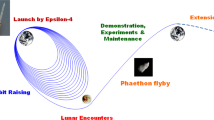Abstract
In the first mission to Pluto, the New Horizons spacecraft was launched on January 19, 2006, and flew by Jupiter on February 28, 2007, gaining a significant speed boost from Jupiter’s gravity assist. After a 9.5-year journey, the spacecraft will encounter Pluto on July 14, 2015, followed by an extended mission to the Kuiper Belt objects for the first time. The mission design for New Horizons went through more than five years of numerous revisions and updates, as various mission scenarios regarding routes to Pluto and launch opportunities were investigated in order to meet the New Horizons mission’s objectives, requirements, and goals. Great efforts have been made to optimize the mission design under various constraints in each of the key aspects, including launch window, interplanetary trajectory, Jupiter gravity-assist flyby, Pluto–Charon encounter with science measurement requirements, and extended mission to the Kuiper Belt and beyond. Favorable encounter geometry, flyby trajectory, and arrival time for the Pluto–Charon encounter were found in the baseline design to enable all of the desired science measurements for the mission. The New Horizons mission trajectory was designed as a ballistic flight from Earth to Pluto, and all energy and the associated orbit state required for arriving at Pluto at the desired time and encounter geometry were computed and specified in the launch targets. The spacecraft’s flight thus far has been extremely efficient, with the actual trajectory error correction ΔV being much less than the budgeted amount.
Similar content being viewed by others
References
R.W. Farquhar, S.A. Stern, Planet. Rep. 10, 18–23 (1990)
Y. Guo, R.W. Farquhar, in New Horizons Mission Design for the Pluto–Kuiper Belt Mission, AIAA-2002-4722, AIAA/AAS Astrodynamics Specialist Conference and Exhibit, Monterey, CA, August 5–8, 2002
Y. Guo, R.W. Farquhar, Acta Astronaut. 56, 421–429 (2005)
Y. Guo, R.W. Farquhar, Acta Astronaut. 58, 550–559 (2006)
D.C. Jewitt, J.X. Luu, Nature 362, 730–732 (1993)
J.W. Keller, in Grand Tour Surveys of the Outer Solar System, Advances in the Astronautical Sciences, vol. 29, part I, ed. by J. Vagners (1971), pp. 37–47
E.J. Long, Astron. Aeronaut. 7, 32–47 (1969)
M.A. Minovitch, J. Spacecr. Rockets 31, 1029–1037 (1994)
NASA, Announcements of Opportunity, Pluto–Kuiper Belt Mission, AO 01-OSS-01, January 19, 2001
J. Spencer, M. Buie, L. Young, Y. Guo, A. Stern, Earth Moon Planets 92, 483–491 (2003)
R.L. Staehle, R.J. Terrile, S.S. Weinstein, Planet. Rep. 14, 4–11 (1994)
S.A. Stern, J. Mitton, Pluto and Charon (Wiley, New York, 1998)
S. Weinstein, Pluto Flyby Mission Design Concepts for Very Small and Moderate Spacecraft, AIAA-92-4372, AIAA/AAS Astrodynamics Conference, Hilton Head Island, SC, August 10–12, 1992
Author information
Authors and Affiliations
Corresponding author
Rights and permissions
About this article
Cite this article
Guo, Y., Farquhar, R.W. New Horizons Mission Design. Space Sci Rev 140, 49–74 (2008). https://doi.org/10.1007/s11214-007-9242-y
Received:
Accepted:
Published:
Issue Date:
DOI: https://doi.org/10.1007/s11214-007-9242-y




